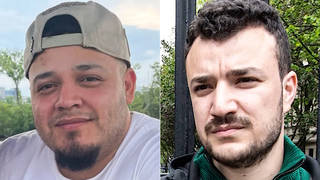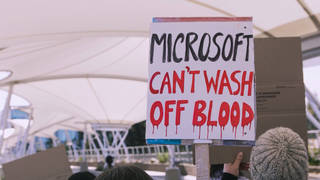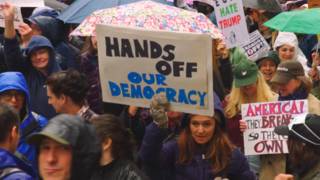
Undocumented immigrants are one of the largest growing populations being detained by the U.S government. We look at the issue of immigration detention, focusing on the treatment of immigrant detainees, the trend towards privatization of detention centers and the policies behind it all. [includes rush transcript]
- Judy Greene, justice policy analyst for Justice Strategies, an organization which conducts research and policy analysis on immigrant detention issues and policies and other issues relating to the criminal justice system.
- Mark Dow, author of, “American Gulag: Inside U.S Immigration Prisons” He is also the author the co-editor of “Machinery of Death: The Reality of America’s Death Penalty Regime.”
- Debi Sanders, executive director of the Capital Area Immigrant Rights Coalition and a member of the Detention Watch Network.
Transcript
AMY GOODMAN: We’re joined in our Firehouse studio by Sharon Nyantekyi. Sharon recently spent a number of days in a detention center run by Corrections Corporation of America in Elizabeth, New Jersey, taken into custody after applying for a green card, married to an American citizen. We are also joined in the studio by Judy Greene, an analyst with Justice Strategies, and by Mark Dow, who is the author of the book, American Gulag: Inside U.S. Immigration Prisons. We welcome you to Democracy Now! Judith Greene, C.C.A. and immigrant detention — first, the overall prison system, and then, the specific subset of immigration prisons.
JUDY GREENE: Well, C.C.A. is the largest private prison corporation in the world and in the United States. They have some 60,000 prison beds that they manage. They house prisoners from the federal prison system, from state prison systems, and they have an increasing share of contracts to house immigrants in their detention centers. The company actually started — the very first private prison in the world was an immigrant detention center in Houston, Texas: the Houston Immigrant Processing Center, which C.C.A. still operates. And Texas continues to be the ground zero of the immigrant detention industry.
AMY GOODMAN: And how has it grown? And is it increasing, the privatization of U.S. prisons?
JUDY GREENE: In the last decade, with increased emphasis on immigrant enforcement, the immigrant detention system, the little industry, has tripled in size to a capacity now of some 22,000 beds. Some of these beds are private. Some of these beds are operated by ICE. Some of these beds are in jails, contracted similar to the jail that Sharon was held in. But the private sector is gobbling up an increasing share of these resources. Now, since 9/11, there’s been an increased blurring of the line between immigrant enforcement and law enforcement. And now, with the hyper-politicized immigration reform debate, we’re seeing bills that would completely erase that line.
AMY GOODMAN: Talk about the significance of this. I mean, you have the situation of Sharon, you have the situation of Carolina. No criminal charges had been brought against them. What do you mean by the blurring?
JUDY GREENE: Well, pressure is increasing on state and local law enforcement to enforce immigration laws, and some states — Florida, Alabama, Arkansas — have already made agreements with the federal government, so that state and local police are trained to look for undocumented immigrants and ostensibly to bring them into the immigrant detention industry or facilities for purposes of removal.
What we’re seeing in Alabama, for example, immigrants are being stopped at checkpoints or stopped for making illegal left turns in their cars or even jaywalking. Local police then inspect whatever documents they may have, and if those documents appear to be false, they’re being taken into custody, charged with felony fraud, held in jail with no bail, and processed in our criminal courts, which then, of course, if they’re convicted and they go to prison, at the end of that, they get processed into the detention system for removal.
AMY GOODMAN: You could have a woman who calls the police in a domestic violence situation, and the police come and then arrest her?
JUDY GREENE: Absolutely.
AMY GOODMAN: Mark Dow, you’ve written this book, American Gulag: Inside U.S. Immigration Prisons. Can you talk about the difference between immigration prisons and other prisons? Is there a difference?
MARK DOW: Well, there’s a difference, in name, and that’s an important question. The reason I use the phrase “immigration prisons” is because we talk a lot about detention. We’re hearing a lot about detention. But when people are detained, they are incarcerated. They are prisoners. They’re stripped of their clothing. They’re given inmate uniforms. It’s not that they’re treated like prisoners, they are prisoners. So even though this is administrative, quote-unquote, “detention,” it has nothing to do with serving time for a sentence. These people are jailed as prisoners, and they are in jails, they are in prisons, and sometimes in what are called detention centers or processing centers, but as a warden once told me, these are all the same thing.
AMY GOODMAN: Can you talk about some of these detention centers, from Krome in Miami, Dade County, to others?
MARK DOW: Well, the main thing to realize about them is that it’s a whole network of detention centers and prisons around the country, so wherever someone is hearing this broadcast right now, there’s most likely a prison or jail or detention center with non-citizens being held there pretty close to where they are. It’s a decentralized system.
Part of the problem for these immigration prisoners, like some of the ones that have been talking to you today, is that they are isolated from families. They’re isolated from legal help. They are often put in rural areas, where there simply aren’t lawyers in the area who can help them. And none of that is an accident. In fact, often if immigration prisoners are in a big city, where they might have legal help or family support, the immigration agency, ICE, will often move them to isolated rural areas to make sure that they’re more cut off and more isolated. So the immigration service actively works to cut them off from the little due process that’s available to them.
AMY GOODMAN: The number of people who are immigrants, who are now detained?
MARK DOW: Something like 22,000 right now. And the important thing to remember about that number is that a lot of people think that immigration detention appeared after September 11th, and people think that, 'Okay, well, even if there are some problems, it was September 11th, so we had to detain people.' But on September 10, 2001, there were already some 20,000 to 22,000 immigration detainees around the country.
AMY GOODMAN: You’re saying there aren’t more.
MARK DOW: Well, we don’t know the exact numbers, but — and there’s a lot of turnover. But what I’m saying is that this immigration detention system didn’t just start recently because of a national emergency. It’s been in place since the Reagan era in its current form, although it’s expanding exponentially, particularly since the 1996 anti-immigrant laws.
AMY GOODMAN: With the legislation that’s being debated right now in Congress, what applies to the jails?
MARK DOW: Well, it’s not clear what the increase in bed space will be yet, but one of the provisions that’s being talked about could increase the number of detention beds by the tens of thousands. 20,000, possibly. So we’re talking about additional expansion, renting more beds in local jails, increased opportunities for the private prison companies that Judy is talking about.
AMY GOODMAN: And the difference in access that immigrants have to lawyers in immigrant jails versus regular prisoners?
MARK DOW: So-called administrative detainees, people in immigration detention, do not have a right to counsel. This is very important to realize, because they’re subject to an adversarial system. They go into a courtroom where there’s an immigration judge, where there’s a prosecutor who works for the immigration service. But those immigration prisoners do not have the right to counsel.
Now, Michael Chertoff, Secretary Chertoff, during his confirmation hearings, seemed to imply that in retrospect, the post-September 11th detainees should have had lawyers. Now, I think he basically said that to escape from some questioning from the congressmen, but it’s something that he should be held to, and I think the issue of counsel for any detained immigrant is something that should be on the table. And frankly, it would solve one of the problems that immigration complains about, which is that if you release people from detention, that they tend to abscond, because some statistics seem to show that if an immigrant who has to fight his or her case has a lawyer, then they’re more likely to show up for any proceeding. So, giving them a lawyer will make the system work better all around.
AMY GOODMAN: Sharon, did you have access to a lawyer?
SHARON NYANTEKYI: Yes, I did have a lawyer at the time.
AMY GOODMAN: And how did you get out?
SHARON NYANTEKYI: Well, the lawyer, along with Rutgers University and my husband, had all been petitioning the judge and writing letters. The provost even wrote letters, all my professors wrote letters to the judge, you know, explaining my situation, and he decided to reopen my case. So that means I got out on bail, and I go before the judge again on May 9.
AMY GOODMAN: I wanted to turn back to Debi Sanders of CAIR, the Capital Area Immigration group. And ask you in Washington, if you go encourage people to go to ICE, to the Immigration and Customs Enforcement now, given the situation of young women like Carolina and what’s happened to her.
DEBI SANDERS: If we are representing somebody initially, we do research on what their case is and what their situation is. And then we would want to accompany them and make sure all their papers were in order. Unfortunately, Carolina went alone. And then was arrested alone. And now, we obviously, once people knew her story, two fabulous law firms are representing her. And we hope to bring her back through processing. But that can take many, many months because of those delays. But I think what’s really important on the show this morning, we’ve heard from so many mothers and wives, to show that people like Carolina obviously she’s not a security risk. She doesn’t have anything to do with national security. Were she to have been released, to be here during her hearing, she clearly wasn’t a flight risk. She has a husband, she has a child. This is exactly the kind of person that would stay here during her hearing. And to follow up on the Washington immigration office, for example, holds the majority of the people that they arrest in two jails. One is 150 miles from D.C. And the other is 206 miles from D.C. making it hard to get lawyers and family to help them.
AMY GOODMAN: I should say we invited on ICE, the immigration customs enforcement and they said they wouldn’t come on. Last month, following the massive raids, the largest enforcement operation in U.S. history, D.H.S. Secretary Michael Chertoff announced a second component of the secure border initiative called the interior enforcement strategy. Mark Dow, can you explain what that is?
MARK DOW: Well, in general, the Interior Enforcement Strategy is bureaucratic talk for cracking down on alleged illegal immigrants who are in the interior, meaning farther away from the borders. So, it’s stepped-up raids. It’s trying to round up what immigration likes to call “fugitives,” because it’s an evil-sounding word, but could range from any kind of bureaucratic slip-up in paperwork to someone who really doesn’t have a case. So, it also involves — we were talking before about the intersection of immigration detention and the jails. The other part of the Interior Enforcement Strategy involves looking for non-citizens who are serving sentences so that their removal, their deportation, can be expedited.
AMY GOODMAN: And then, Debi, you have people like Hannah, who is a woman who stole a t-shirt. They serve time, and then they’re held indefinitely. Can you explain why? And we just have a few minutes.
DEBI SANDERS: Right. What happened — Hannah was a lady, she was a cook in a local restaurant. She had a green card for 25 years. She, twelve years ago, stole one shirt from a department store. The criminal judge, of course, gave her no criminal time, merely community service. But now, because there’s no statute of limitation, then any-level crime — more and more, minor crimes can make you deportable, even if you have a green card. She is now in deportation proceedings, in detention. Again, someone not a danger, not a flight risk. So this is the kind of people that the Homeland Security is arresting.
Before their numbers were smaller; they were arresting people who truly had more serious issues, who might have been flight risks, who might have had issues that made them a danger to our community. But, more and more, we see the numbers going up, and because the numbers are going up, the time in detention is also going up, because it used to take a few weeks to be deported, now it’s taking months and months. Even this supreme court has said that ICE can only hold people in jail for six months before they have to either deport them or release them. More and more, we see ICE going over even that six-month deadline set up by our current supreme court.
AMY GOODMAN: We only have a few seconds, and I wanted to end with Carolina Hernandez. Your last words from Guatemala City, where you’ve been deported to?
CAROLINA FULECIO HERNANDEZ: Well, all I can say, you know, that — I just, you know — I just want people to help me to get back over there, because I want to be with my family again, and I really miss my son, and I haven’t seen my son for almost four months.
AMY GOODMAN: Carolina, I want to thank you for being with us. We will continue to follow your case. Carolina Hernandez, deported to Guatemala. She came here when she was four years old. Her son is about to turn three.
I also want to thank Sharon Nyantekyi for joining us, who is now out of the Elizabeth Detention Center; Judy Greene; Mark Dow, author of American Gulag: Inside U.S. Immigration Prisons; and Debi Sanders.












Media Options